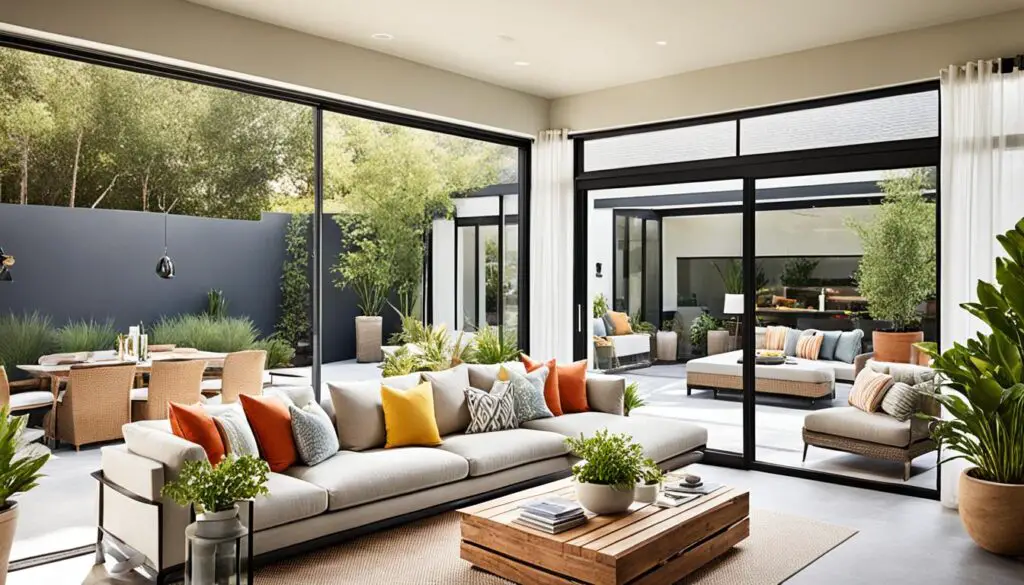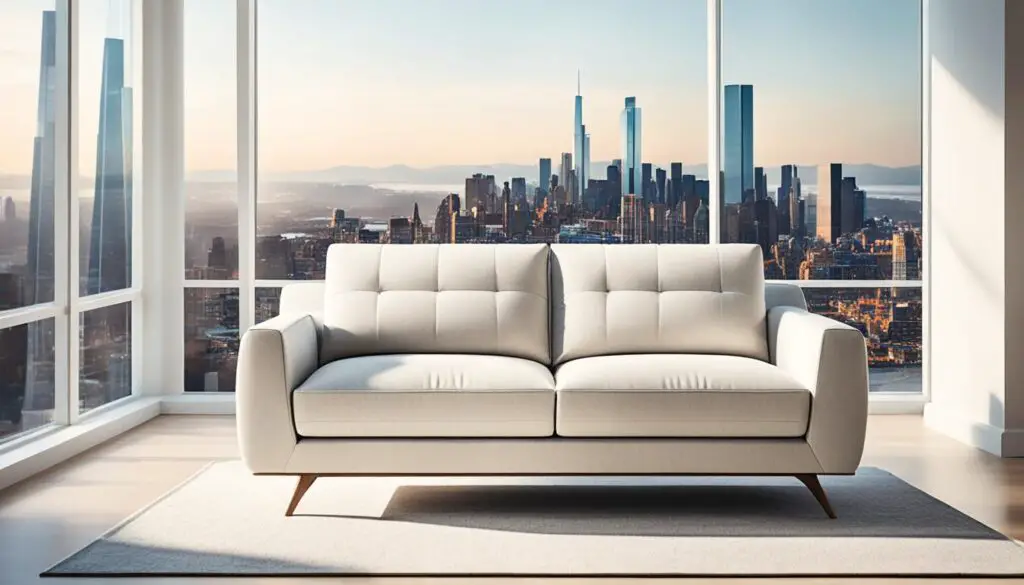
Finding the right living room sofa is key to setting the mood of your space. There are many options, from classic loveseats to modern chaise lounges. Our guide will help you pick the perfect sofa for your home, whether you’re updating or starting fresh.
Arranging Furniture Around a Focal Point
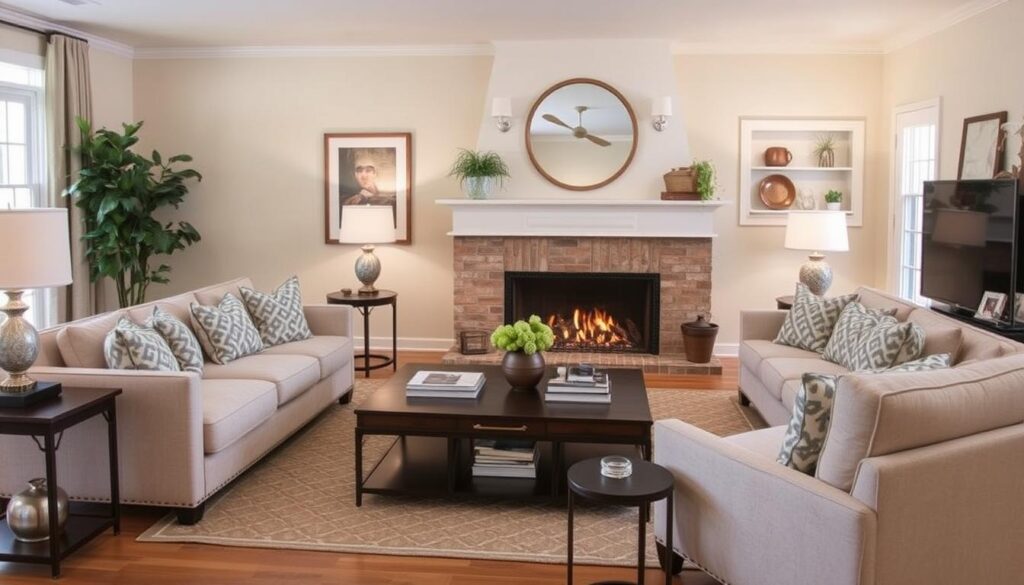
When setting up your living room, find and focus your furniture on the main spot. Usually, a fireplace is this key feature, pulling the eye and setting the room’s mood.
Orienting the Sofa Towards the Main Feature
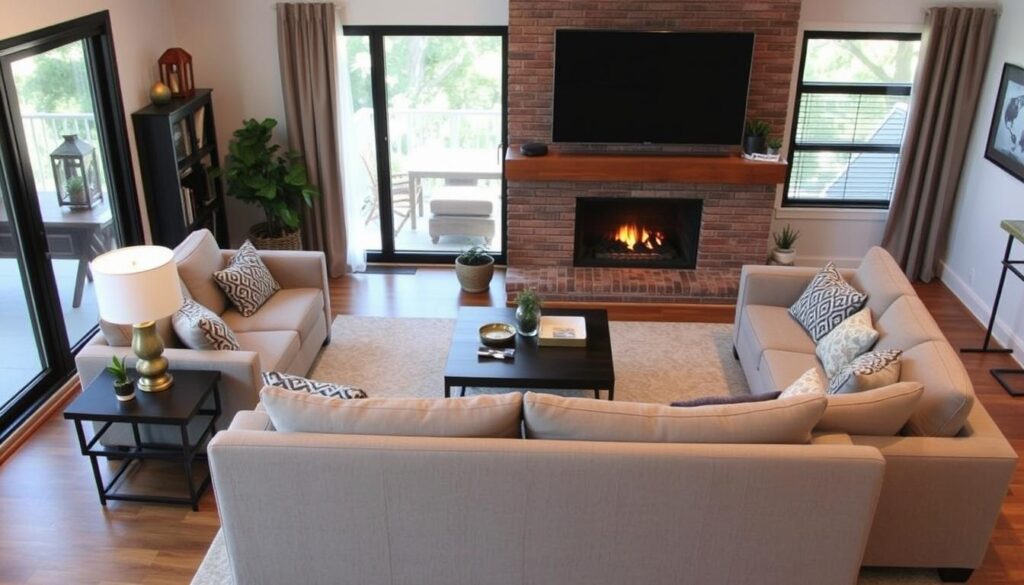
Put your sofa right in front of the focal point. This makes conversation easy and allows for TV watching if you want. Adjust the sofa’s distance from the fireplace to match your room’s size and how close you like to sit.
Positioning Secondary Seating Around the Sofa
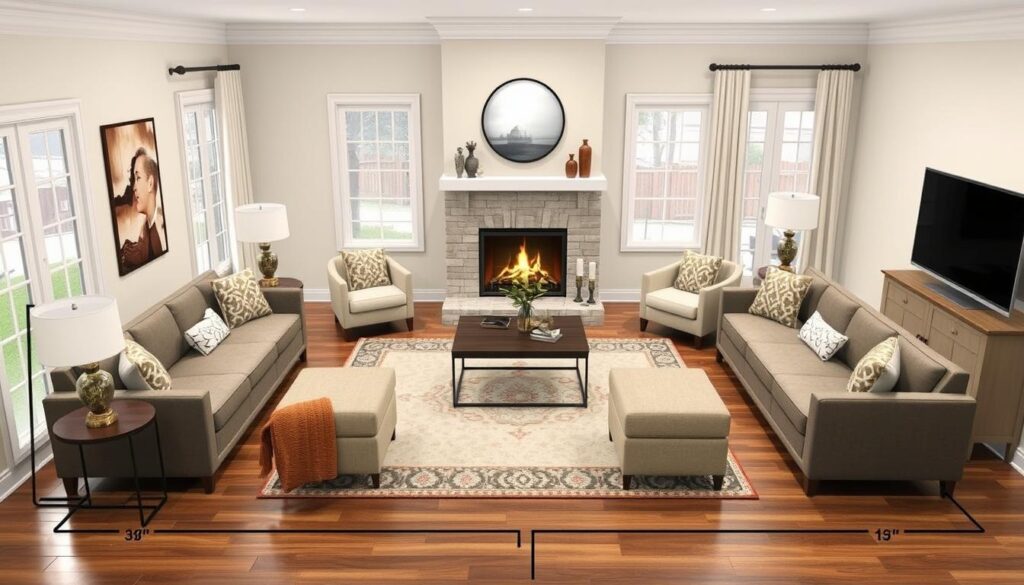
After placing the sofa, add chairs or loveseats around it. This setup makes the room feel welcoming and encourages people to chat. By placing the extra seats smartly, all furniture points towards the fireplace, making the room feel cozy and inviting.
| Living Room Dimensions | Focal Point | Furniture Placement |
|---|---|---|
| 14′ wide x 19′ long | Fireplace | Sofa facing the fireplace Secondary seating (chairs, loveseat) arranged around the sofa Coffee table and rug in the center Minimum 12-18″ clearance between furniture pieces Minimum 36″ from main entryways or doors |
“Arranging furniture around a focal point is key to creating a cohesive and inviting living space. By orienting the main pieces towards the central feature, you can establish a natural flow and encourage meaningful conversations.”
By using these furniture placement tips, you can make your living room both beautiful and practical. It will suit your lifestyle and be great for entertaining guests.
Maximizing Space in Small Living Rooms
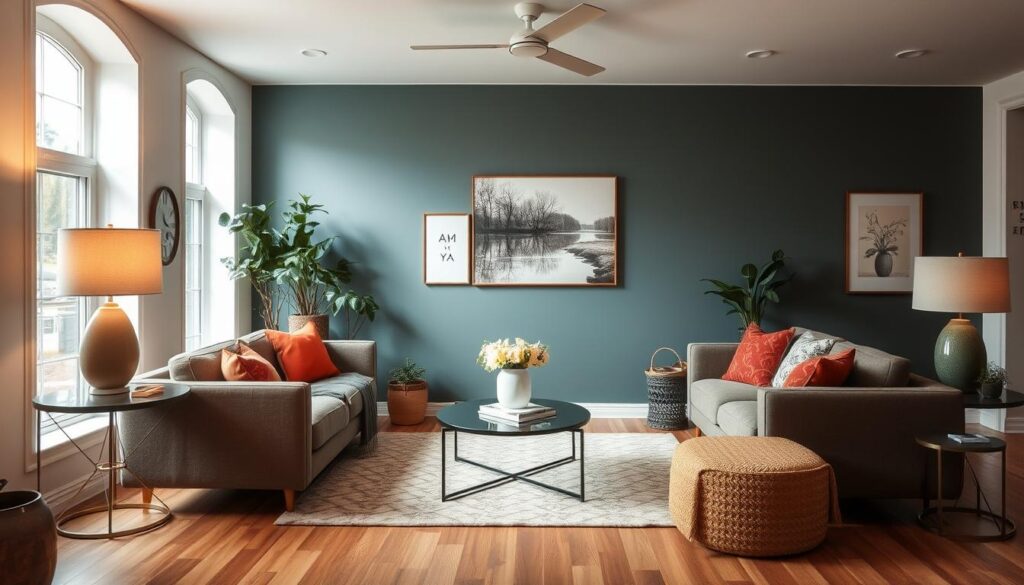
For small living rooms, the secret to a cozy yet functional space is smart furniture arrangement. Don’t believe the myth that pushing all your furniture against the walls is best. This can actually make the room feel cramped. Instead, pull your furniture towards the room’s center.
Pulling Furniture Towards the Center
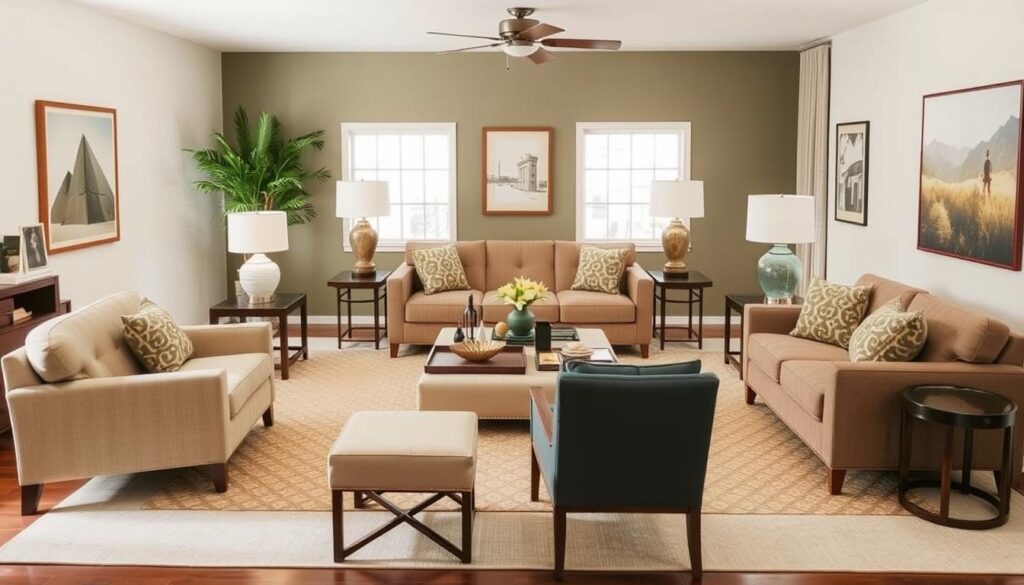
Positioning your sofa, armchairs, and other seating in the room’s middle creates a welcoming atmosphere. This layout makes the space feel bigger and defines where people should sit. Think about using lightweight and flexible furniture pieces, like chairs that can be easily moved and ottomans that can serve as side tables or extra seating. These items let you change the room’s setup for different events.
Utilizing Lightweight and Flexible Pieces
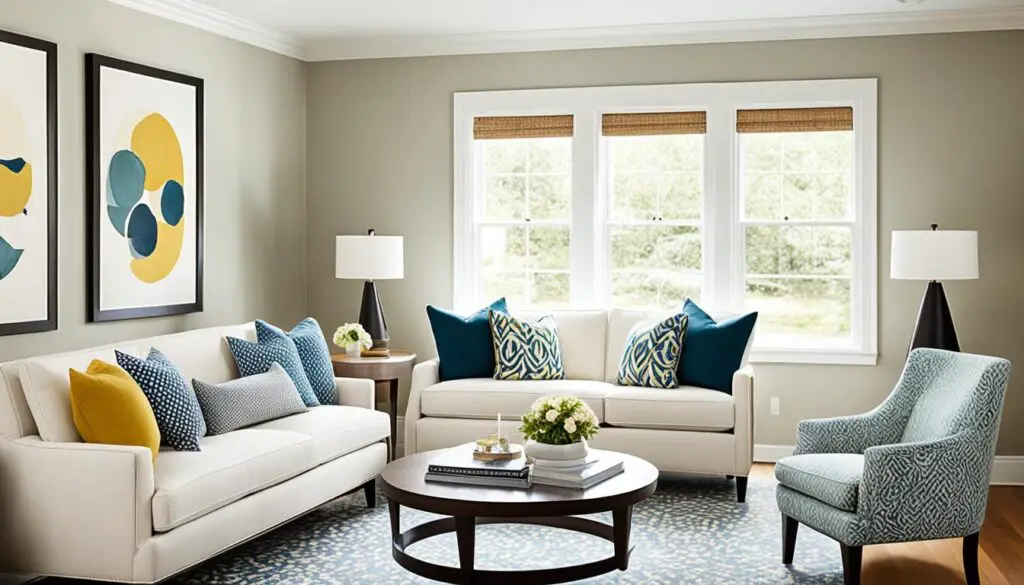
Choose small-scale, lightweight furniture that’s easy to move around. This includes slender armchairs, compact side tables, and modular sectionals. With space-saving and flexible pieces, your small living room will feel open and adaptable. The aim is to use space wisely while keeping the room cozy and inviting.
“The key to a functional small living room is choosing the right furniture pieces and arranging them in a way that maximizes the available space.”
By placing your furniture in the center and picking lightweight, flexible pieces, you can make your small living room feel cozy and welcoming. It will seem much larger than it actually is.
Defining Different Activity Zones
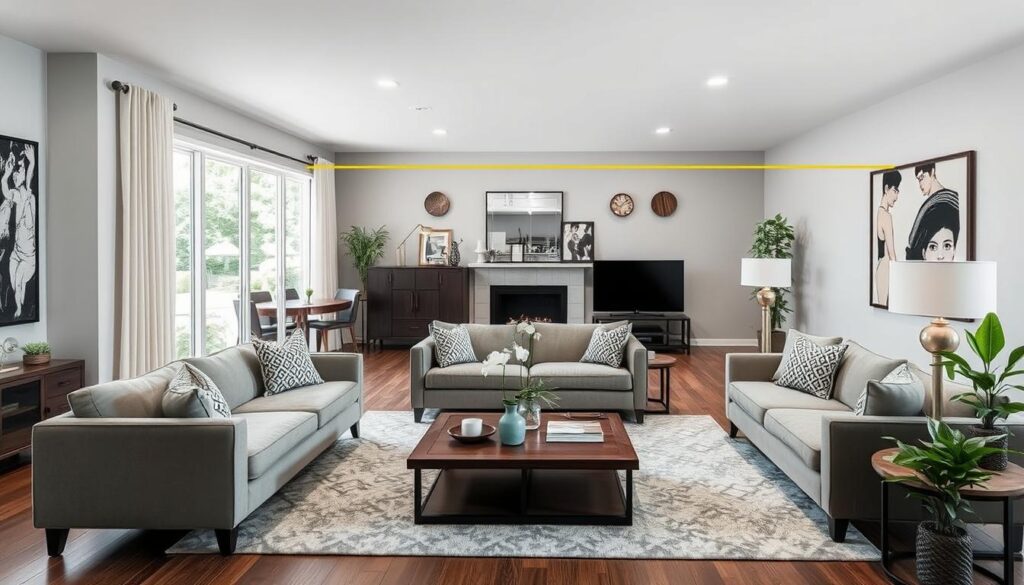
In an open-concept living room, it’s important to arrange furniture with a plan. This way, you can make clear areas for talking, dining, and other activities. This method makes the room flow better and adds purpose to the open layout.
Separating Conversation and Dining Areas
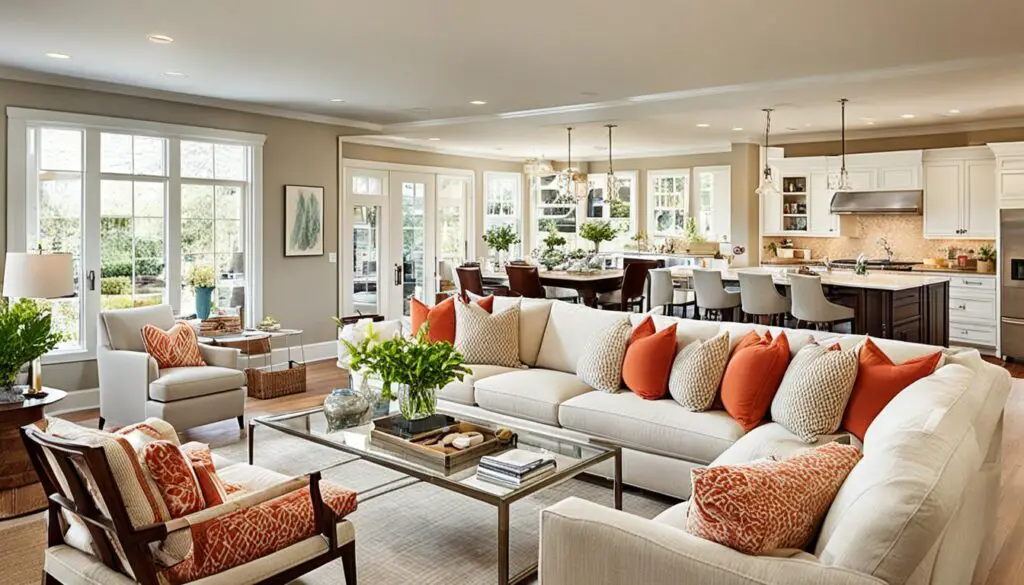
One good way to divide the space is by placing a table and chairs on one side. This area is perfect for eating, playing games, or working. On the other side, put a sofa and armchairs near the fireplace or a main feature. This setup keeps the dining and talking areas separate, making the room feel balanced.
| Activity Zone | Recommended Furniture Arrangement |
|---|---|
| Conversation Area | Sofa, armchairs, and occasional tables centered around a focal point |
| Dining Area | Table and chairs positioned on the opposite side of the room |
| Home Office | Desk, chair, and task lighting in a designated corner or alcove |
By arranging furniture with care and setting clear zones, you can make an open-plan living room work for you. It meets your needs and fits your way of life.
Unifying with an Area Rug
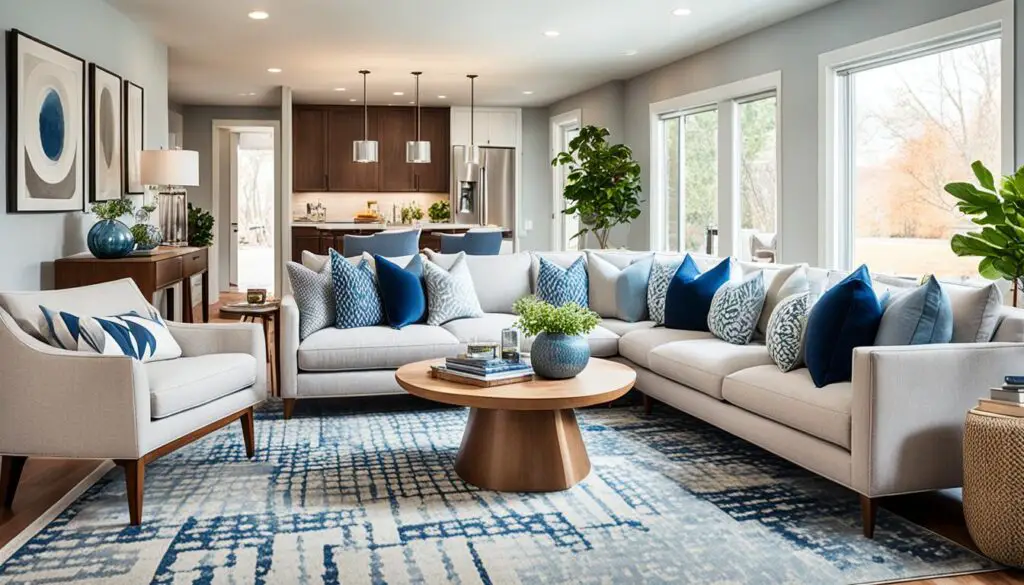
Starting with the right area rug is key to a cohesive living room. A large area rug can bring your seating together and anchor the space. Make sure all your main furniture fits on the rug.
If your rug is too small, ensure the front legs of each piece are on the rug. This connects the room’s elements and brings visual unity. The rug ties your furniture placement and living room layout together.
| Sofa Width | Recommended Rug Size |
|---|---|
| 60-80 inches | 6×9 feet |
| 85-90 inches | 8×10 feet |
| 90-115 inches | 9×12 feet |
| 98-105 x 98-136 inches | 10×14 feet |
For small living rooms, have 6-8 inches of rug beyond the sofa edges. In bigger rooms, aim for 18-24 inches to create a luxurious feel.
Choosing the right area rug size is crucial for your living room’s look. It should match your room’s size and furniture setup. This creates a cohesive, polished look.
Creating Intimate Seating Groups
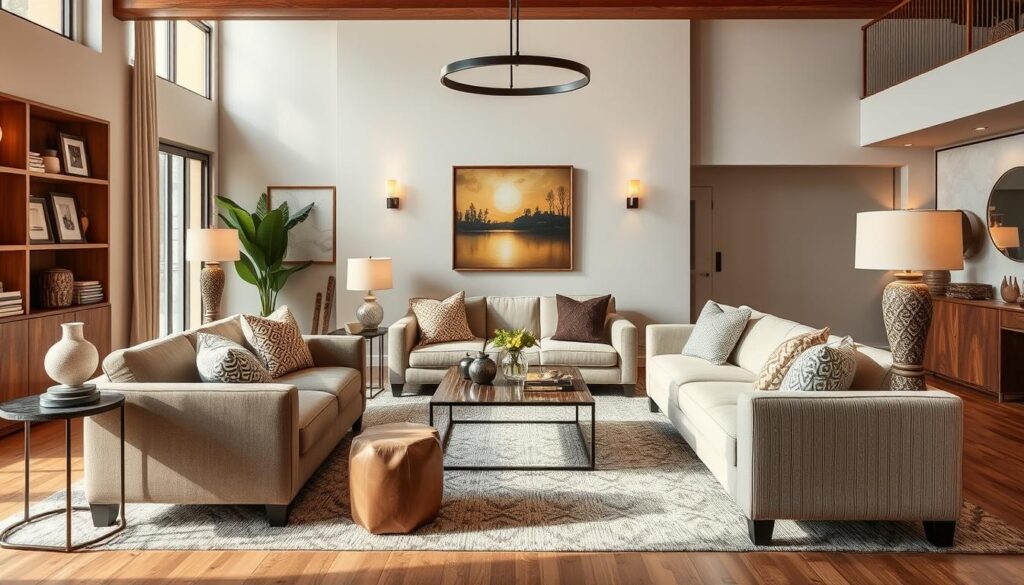
In large living rooms, arranging furniture can make the space feel cozy and intimate. By creating separate areas for conversation, you make the room feel more inviting. This approach encourages people to relax and connect with each other.
Dividing Large Rooms into Cozy Spaces
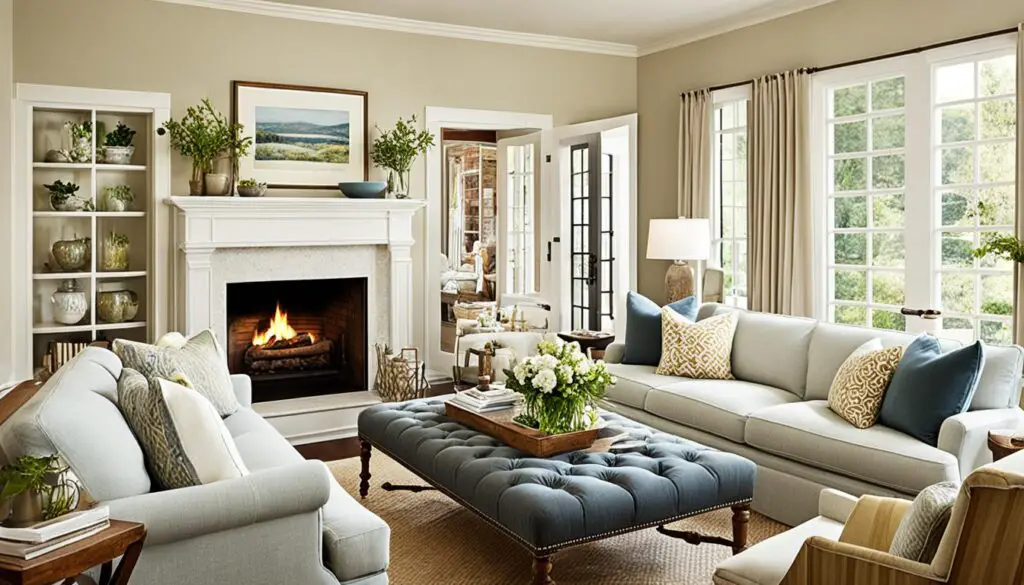
Start by placing one sofa with its back to a central path. This divides the room into two cozy seating areas. It makes each spot feel more private and intimate.
Choose intimate seating like rattan or cane chairs to add to the cozy feel. These options make the space feel more welcoming.
Modern furniture with curves is also great for creating cozy spots in big rooms. Adding antique or vintage pieces adds a unique touch that makes the space feel more intimate.
“Symmetry in interior design is recommended to create a structured and balanced feel in living spaces, utilizing matching pairs such as armchairs and side tables.”
By planning your furniture layout carefully, you can turn a large living room into several intimate seating groups. This setup encourages conversation and helps guests feel at ease. Make sure the furniture is arranged to allow easy movement and keep everyone at the same level for a balanced social setting.
Facilitating Conversation Flow
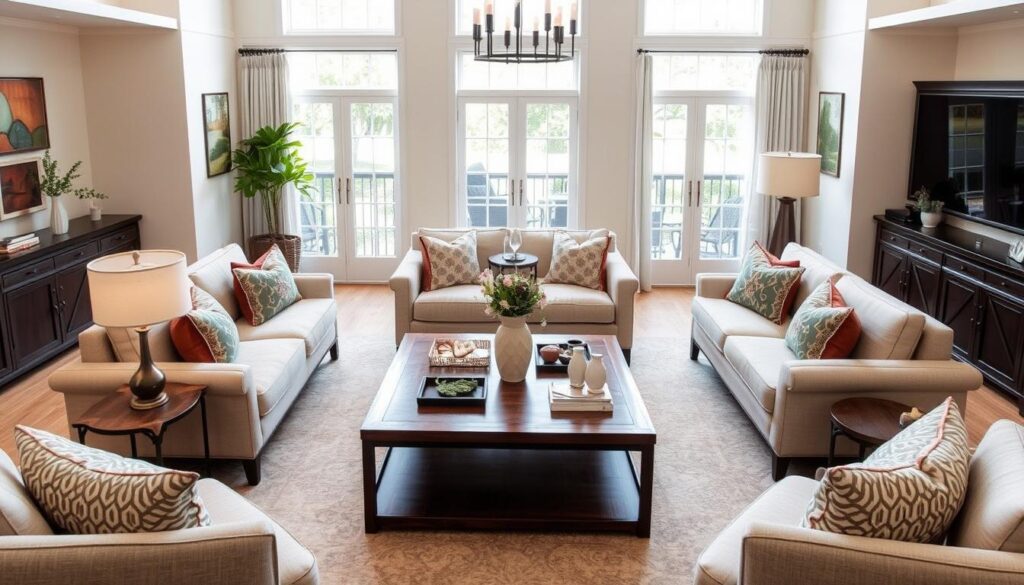
When your living room is the heart of social gatherings, choosing the right furniture layout is key. Make sure the seating is near the room’s center and faces each other. This setup makes for a cozy spot that encourages easy conversation.
Put a coffee table in the middle for drinks and snacks. This layout makes everyone feel at ease, helping conversations to flow well. By having furniture that turns inward, you make guests feel like they’re part of a group. This makes your social gathering more welcoming.
Positioning Seating to Face Each Other
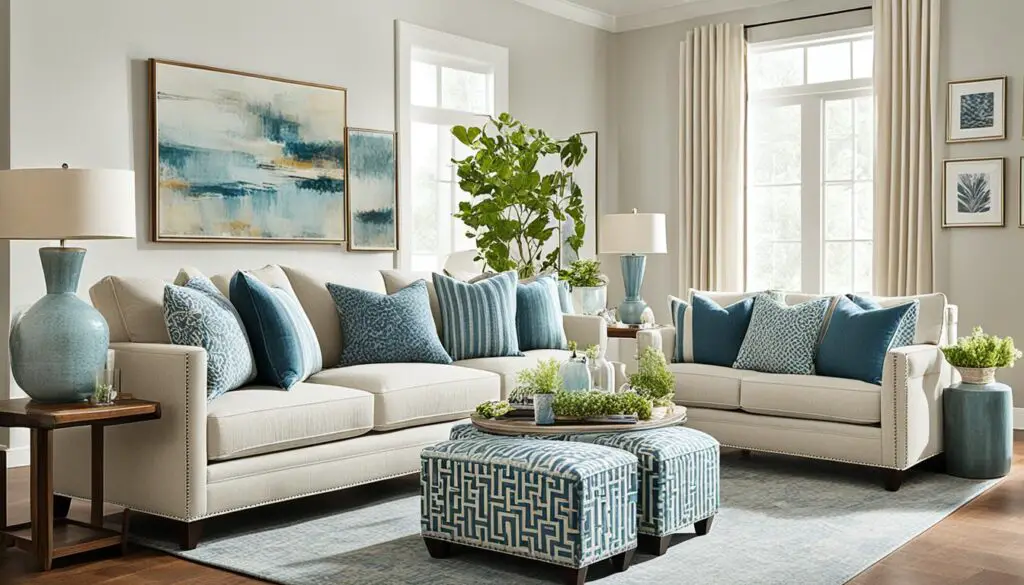
For a living room that’s great for talking, follow these tips for seating arrangement:
- Move sofas and armchairs closer to the room’s center, forming a cozy circle or U-shape.
- Set the furniture so it faces each other, making eye contact and conversation flow easy.
- Add a coffee table or ottoman in the middle to be a key spot.
- Make sure there’s enough room between the seats for easy movement and comfort.
By arranging your living room furniture with care, you make a space that encourages deep talks and connection. This is perfect for your social gatherings.
Embracing Sectional Sofas
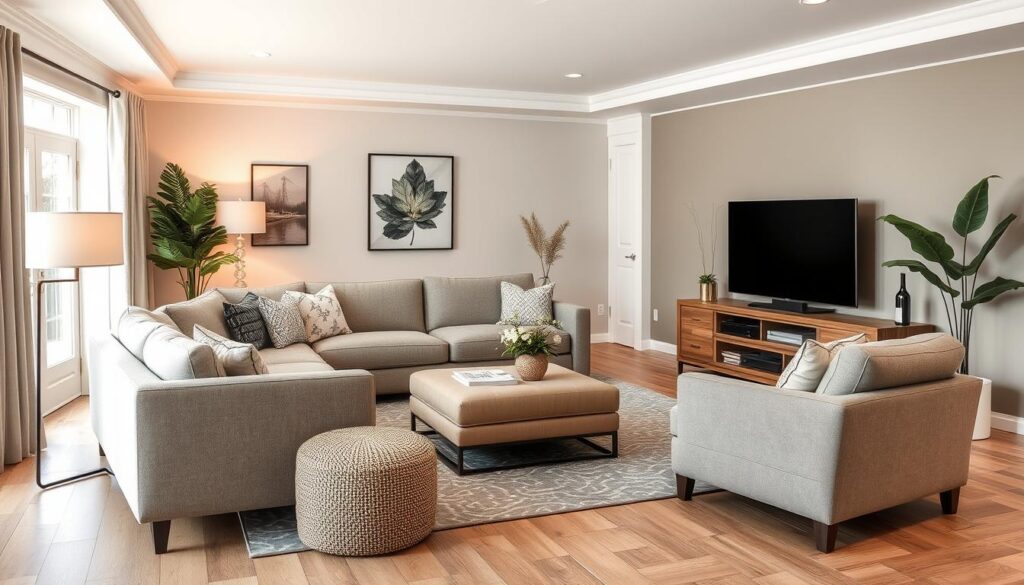
In living rooms where lounging and TV-viewing are key, a sectional sofa is perfect. They come in many styles, like armless chairs, love seats, and ottomans. You can mix them to fit your space. This sofa makes the room feel bigger and offers cozy spots for many people.
Flexible Seating for Lounging and TV Viewing
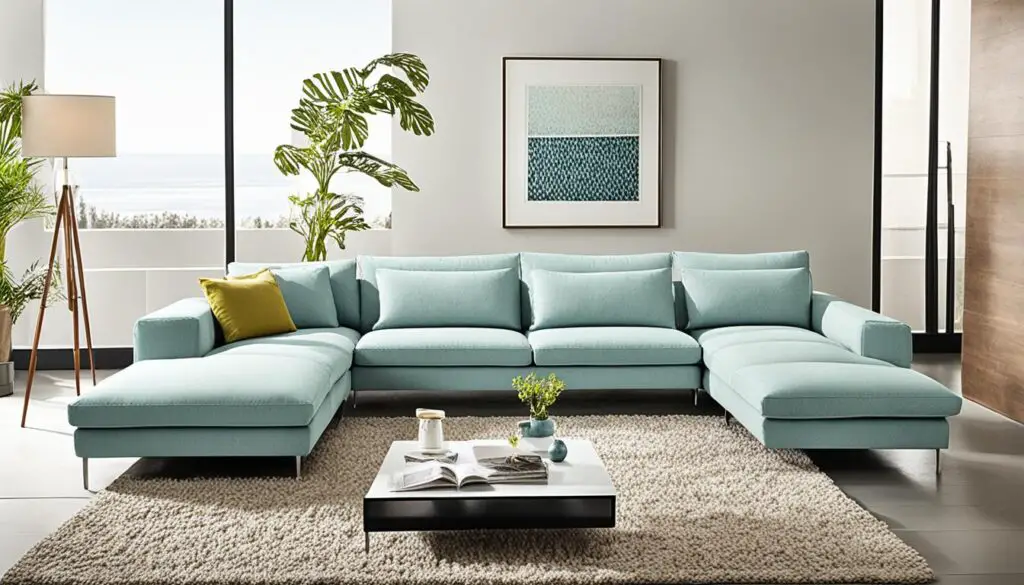
Industry data shows that 70% of large families pick U-shaped sectionals for movie nights. But, 80% of small families or those with less space choose L-shaped sectionals for cozy times at home. Sectional sofas are a hit because they’re adaptable, fitting well in 90% of modern living rooms with open layouts.
| Sectional Sofa Preferences | Percentage of Households |
|---|---|
| U-shaped sectionals for larger families | 70% |
| L-shaped sectionals for smaller families or limited space | 80% |
| Open concept layouts with sectional sofas | 90% |
This sectional sofa is great for lounging and watching TV. It also makes the room feel cozy and welcoming for hanging out with friends or family.
Considering Traffic Flow
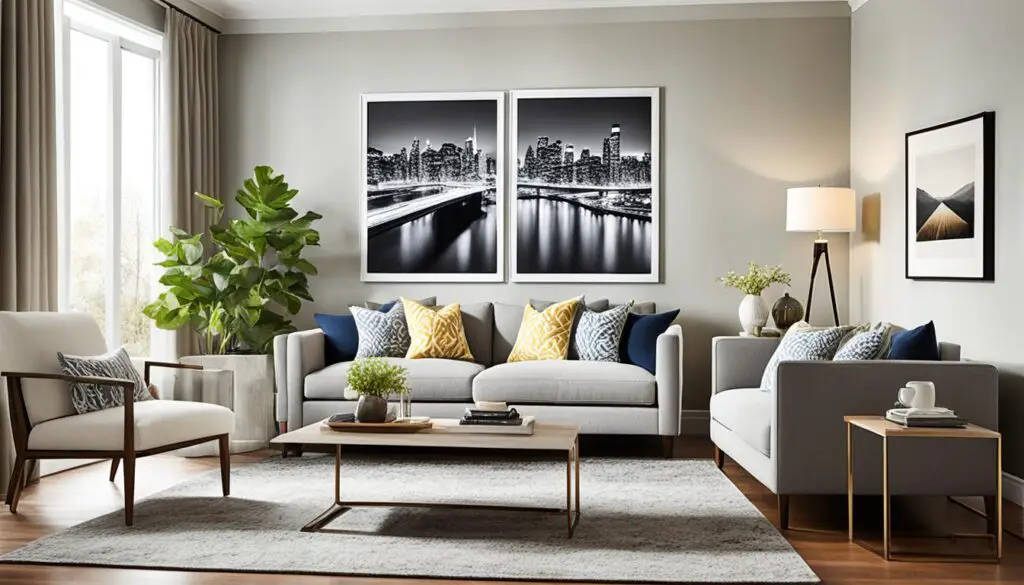
When setting up your living room, think about how people will move through the space. Make sure there are clear paths for everyone to walk around easily. This makes the room feel welcoming and functional.
Interior designers say it’s key to think about traffic flow right from the start. By placing your furniture smartly, you can avoid blockages and make the room more useful.
- Avoid forcing circulation through conversation or TV viewing areas, as this can disrupt the natural flow of the space.
- Ensure there is ample room for people to move around without feeling cramped or having to squeeze between furniture.
- Measure your room and furniture carefully to avoid common mistakes like buying pieces that are too small or too large, which can create an awkward, cluttered layout.
Getting the balance right between looks and function is key in arranging your living room furniture. By thinking about traffic flow, you can make a space that looks good and works well. People will be able to move around easily and comfortably.
A well-designed living room should feel calm and balanced. Don’t put too much furniture or accessories in the room. Too much stuff can make it look busy and mess up the flow.
To get a good layout, pick a main focus point like a fireplace or a special wall. Arrange your furniture around it. This makes the room look planned and improves how people move through it.
Achieving Balance with Symmetry
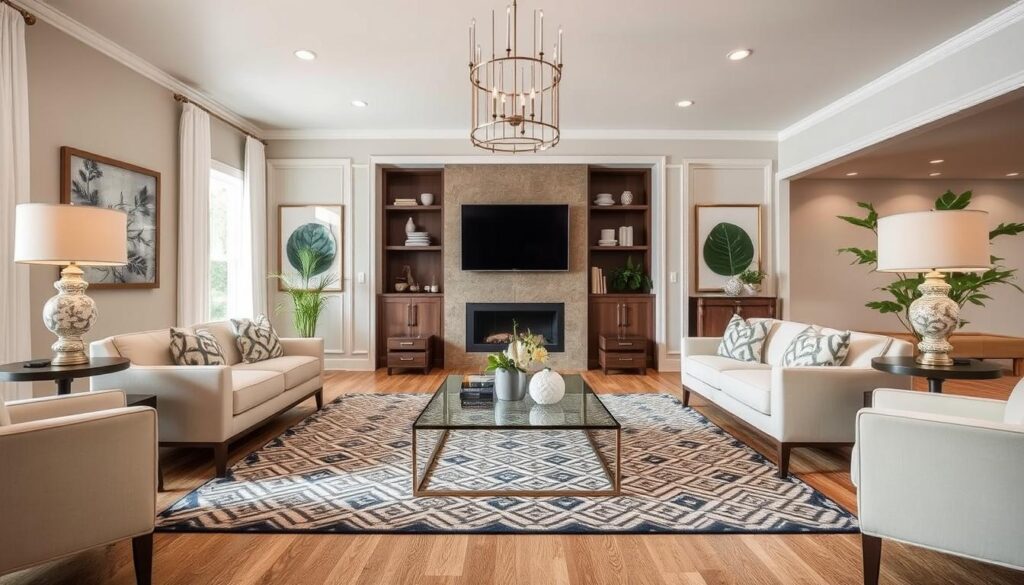
Creating a visually appealing living room involves symmetry. It brings a sense of order and balance, especially in large spaces. Designers suggest placing identical sofas or chairs across from each other for symmetry.
Even if your furniture isn’t a perfect match, you can still aim for symmetry. Place items with similar sizes on both sides of the room. This approach helps create a harmonious design that guides the eye and pleases the senses.
Using Identical or Proportional Pieces
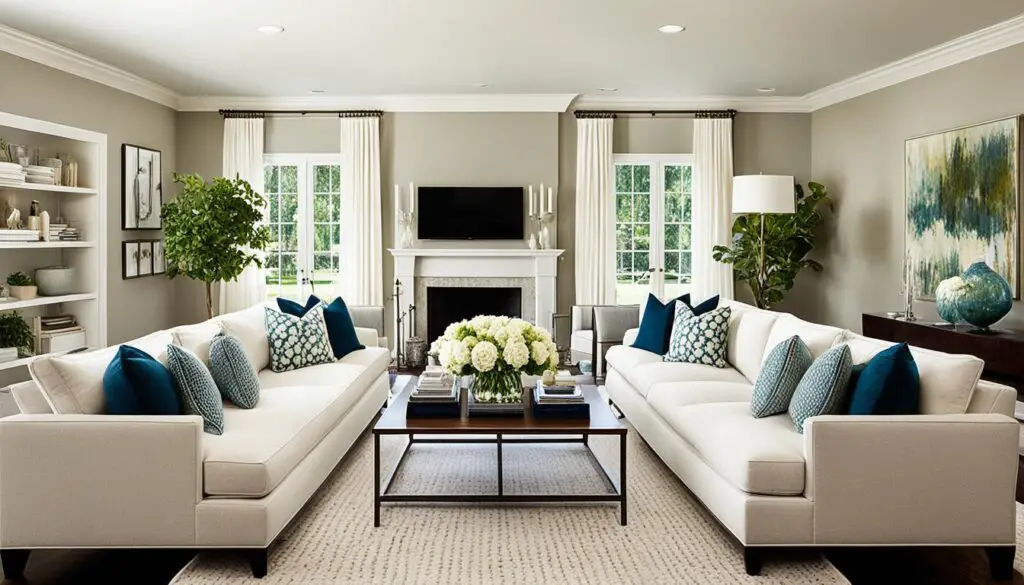
Symmetry is often linked to a formal, traditional look, making up about 30% of living room styles. Asymmetrical balance, however, offers a relaxed vibe, seen in around 45% of modern designs.
When setting up the room, 70% of designers say to think about furniture size and the room’s dimensions for balance. Also, 85% recommend starting with the room’s focal point to guide furniture and create cohesion.
For traffic flow, 60% of designers say to keep paths clear and avoid furniture that blocks movement. 75% believe in considering scale and proportion to maintain harmony and prevent overcrowding.
By thoughtfully placing symmetrical or proportional furniture, you can craft a living room that looks balanced and cohesive. This approach adds a touch of order and sophistication.
living room sofa Options for Different Room Shapes
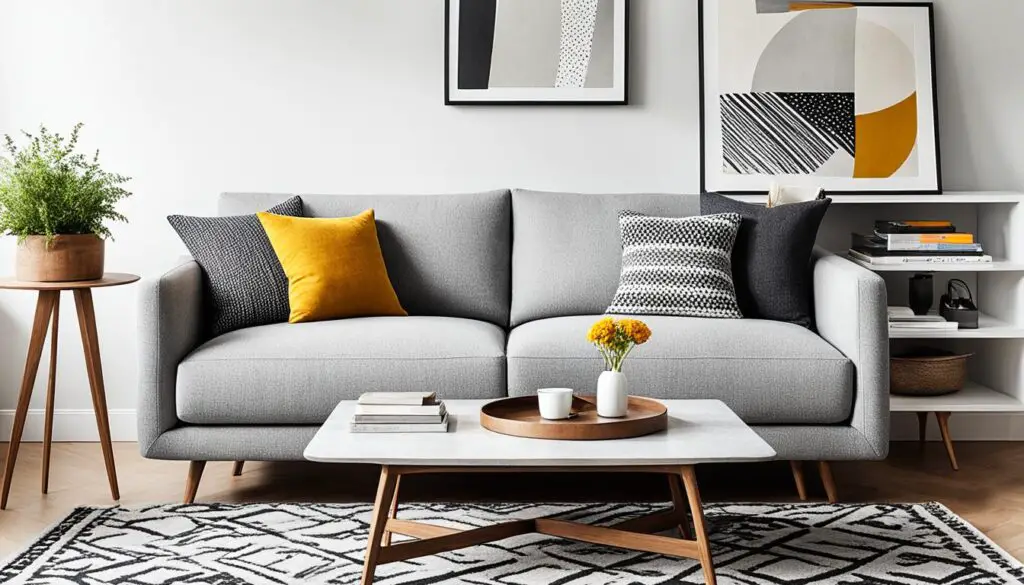
The shape of your living room affects the best furniture arrangement. When picking the perfect living room sofa, think about the room’s size and design. Knowing how different rooms fit various furniture arrangement and layout options helps make a space look good and feel welcoming.
In a long, narrow living room, an L-shaped seating arrangement with a sofa and loveseat works great. This setup defines the space and makes talking easier. On the other hand, a square or rectangular room does well with a symmetrical layout. Using matching sofas or chairs creates a balanced look.
| Room Shape | Ideal Sofa Placement | Key Considerations |
|---|---|---|
| Long and Narrow | L-shaped arrangement | Defines the space, encourages conversation |
| Square or Rectangular | Symmetrical layout with matching pieces | Balanced and cohesive aesthetic |
No matter the room’s shape, think about the furniture arrangement and layout options that fit your space and life. Choosing the right living room sofa makes your room both useful and stylish, showing off your personal taste.
“The shape of the room should dictate the furniture layout, not the other way around. Embrace the architecture and let it guide your design choices.”
– Tracy Morris, Tracy Morris Design
Scaling Down for Small Spaces
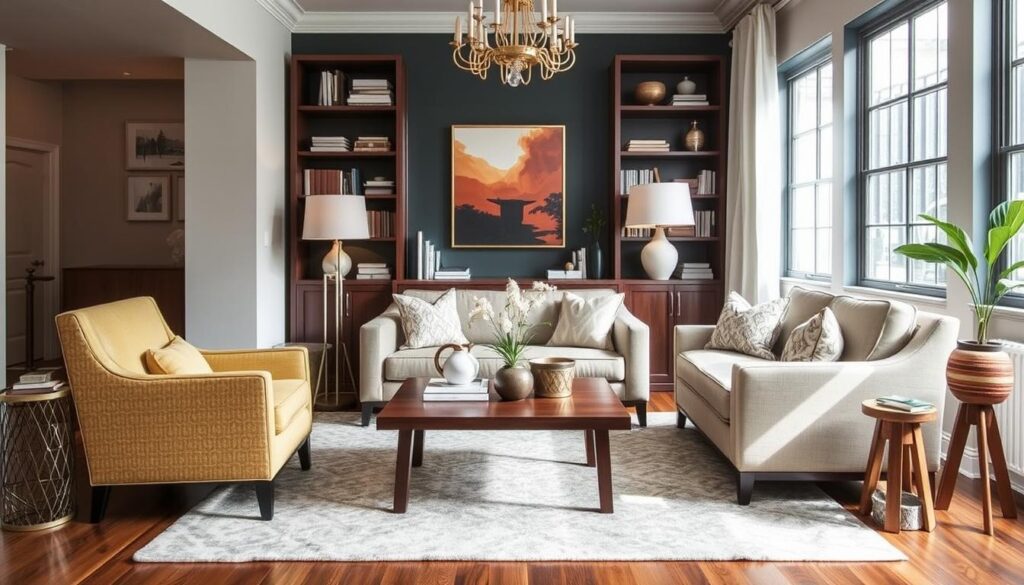
Decorating a small living room means choosing furniture that’s the right size. Instead of big sofas, go for a set of chairs. These armchairs fit well in smaller rooms. And, stools can replace big ottomans, offering flexible and useful seating options.
Choosing Chairs Over Bulky Sofas
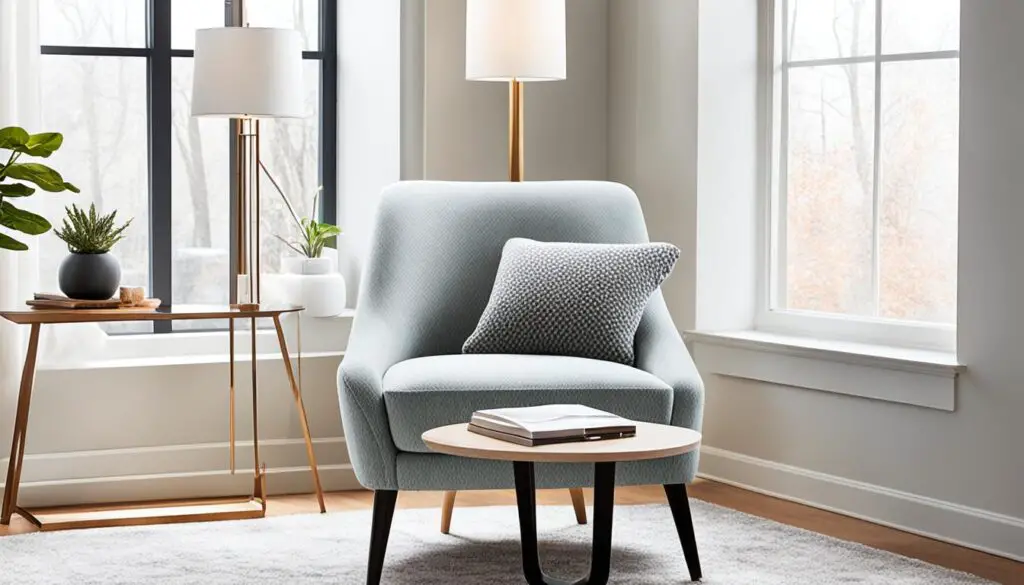
In a small living room, the right furniture scale is key. Big sofas can make the room feel tight and messy. Choosing chairs instead makes the space feel welcoming and open. These sofa alternatives use less space, helping with space-saving and keeping the room open.
It’s not just the furniture size that matters, but how it fits in the room. Pairing your chairs with light, flexible items like end tables adds to the room’s spacious feel.
“Neutral colors like soft beige, creamy white, and light gray are recommended for sofas in small living rooms as they help create a sense of openness and spaciousness.”
With careful furniture choices and an eye on scale, you can make your small living room feel cozy yet spacious.
L-Shaped Seating Arrangements
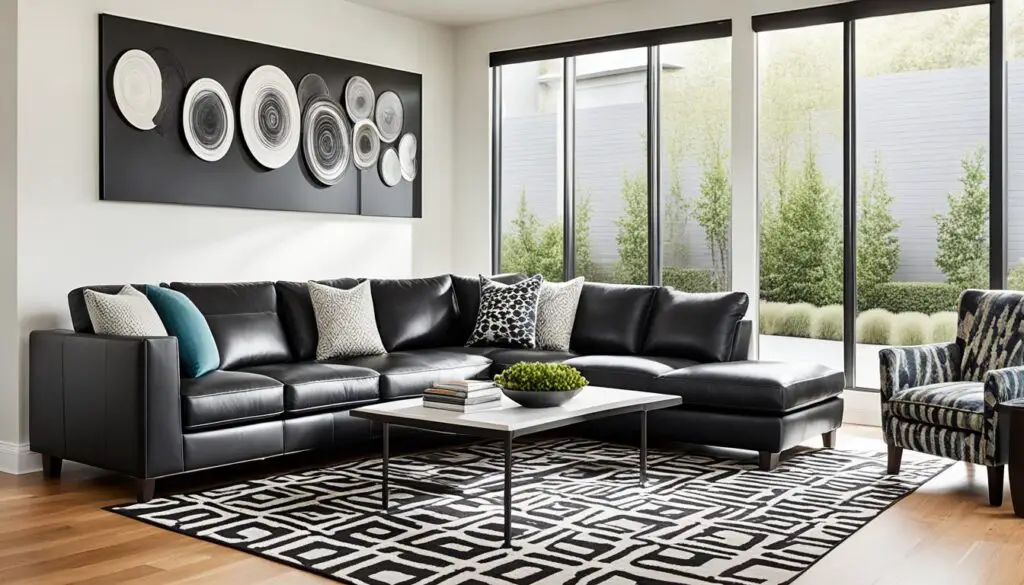
Make your living room more functional and cozy with an L-shaped seating setup. This layout puts a sofa and a loveseat together at an angle, making a cozy spot around a big coffee table. Add an end table or a stylish lamp where the two pieces meet for a neat look.
An L-shaped seating setup is very versatile. It fits well in both small and big living rooms, using space wisely. In small rooms, it creates clear areas. In big rooms, it makes a cozy spot. It’s perfect for families or when you often have guests over.
- The L-shaped sofa and loveseat combo can sit 6-7 people, great for big living rooms.
- Some L-shaped sofas have recliner seats at both ends for extra comfort.
- Sectional sofas can be moved around and fit through most doors.
- L-shaped sofa beds save space and are good for small homes with guests.
Think about your room’s layout and how people move through it when setting up your L-shaped seating. Place it so it looks at a fireplace or TV for a natural spot to talk. Use tables, lamps, and other decor to make the room look better.
| Benefit | Explanation |
|---|---|
| Maximizes Seating Capacity | An L-shaped sofa can sit 6-7 people, ideal for parties or big families. |
| Flexible Arrangement | Sectional sofas can be moved to fit your space needs. |
| Space-Saving Solution | L-shaped sofa beds are great for small spaces and guests. |
Choosing an L-shaped seating setup makes your living room cozy and inviting. It uses space well and offers plenty of seating for everyone.
Diagonal Furniture Placement
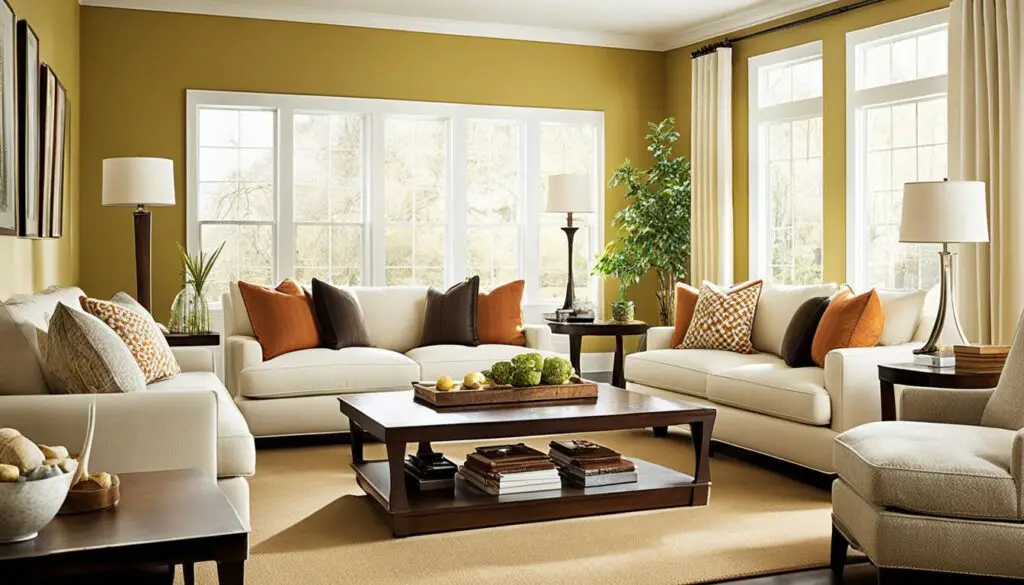
Putting your living room furniture diagonally can change the look of a boxy space. It makes the room feel more alive with dimension and inviting paths. This way of arranging your living room layout uses diagonal lines to make the room more interesting and improve its flow.
Start by placing your sofa and coffee table diagonally across the room. Then, add more seating along the same line. This makes a smooth, intentional path that leads guests to the cozy spot. Make sure the area rug is aligned with a key feature like a fireplace or a statement wall to tie everything together.
Using diagonal furniture placement breaks up the room’s rectangular shape, adding life and visual appeal. It’s great for rooms with many doorways or unique angles. It helps create inviting pathways and makes the most of the room’s dimension.
Try out different setups to see what works best for your living room. Move your sofa, chairs, and other pieces around until you find the perfect arrangement. With some creativity, you can turn your living space into a cozy, captivating spot for everyone.
Embracing Architectural Features
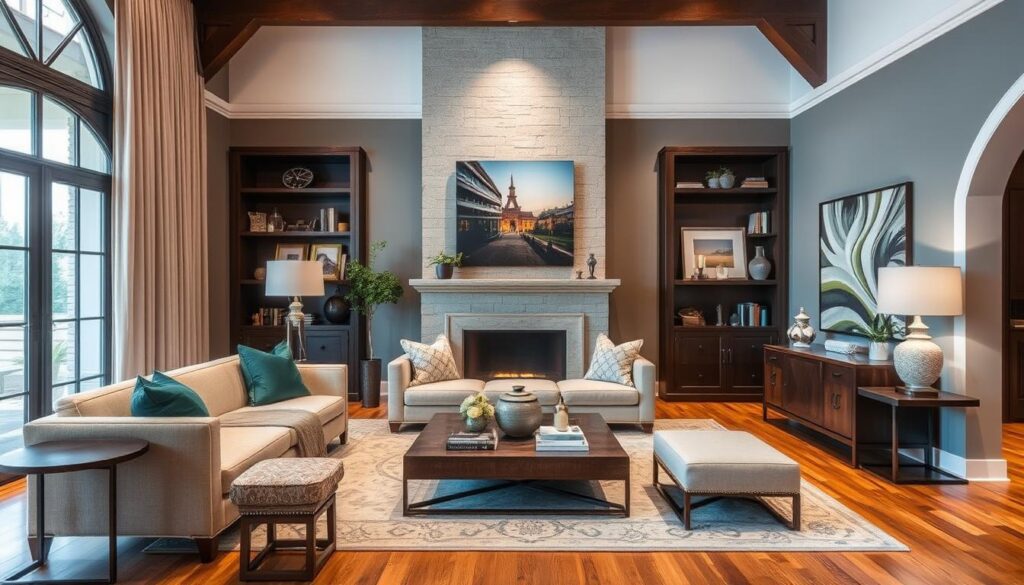
When setting up your living room, think about the unique features of your space. These special elements can become the main focus and guide your layout. By placing your furniture to highlight these features, you make your design look better and more connected.
Positioning Seating Near Windows or Fireplaces
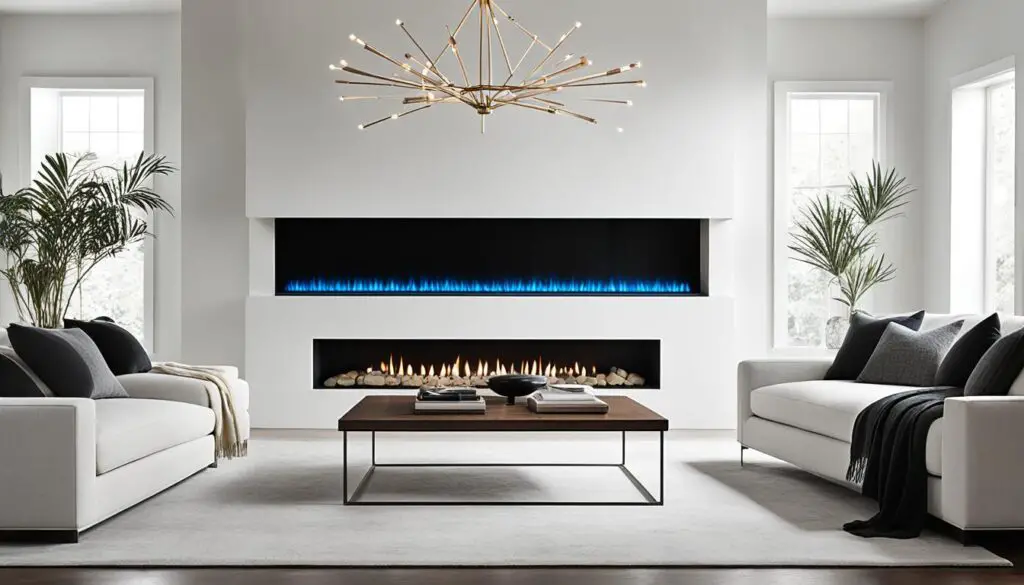
Big windows can make a sunny spot perfect for a cozy seating area. Put a pair of comfy chairs and some stools or tables in front of these windows. This turns the bright corner into a great spot for chatting.
Fireplaces are often the heart of a living room. Placing seating like two sofas or a sofa and chairs around it makes the room look good and useful.
“Using architectural elements like fireplaces and windows as focal points can elevate the design of a living room and create a sense of balance and harmony.”
Think about how to show off these special features in your furniture setup. By using the unique parts of your space, you make your living room both beautiful and useful for everyday life.
More Living Room Sofas ideas
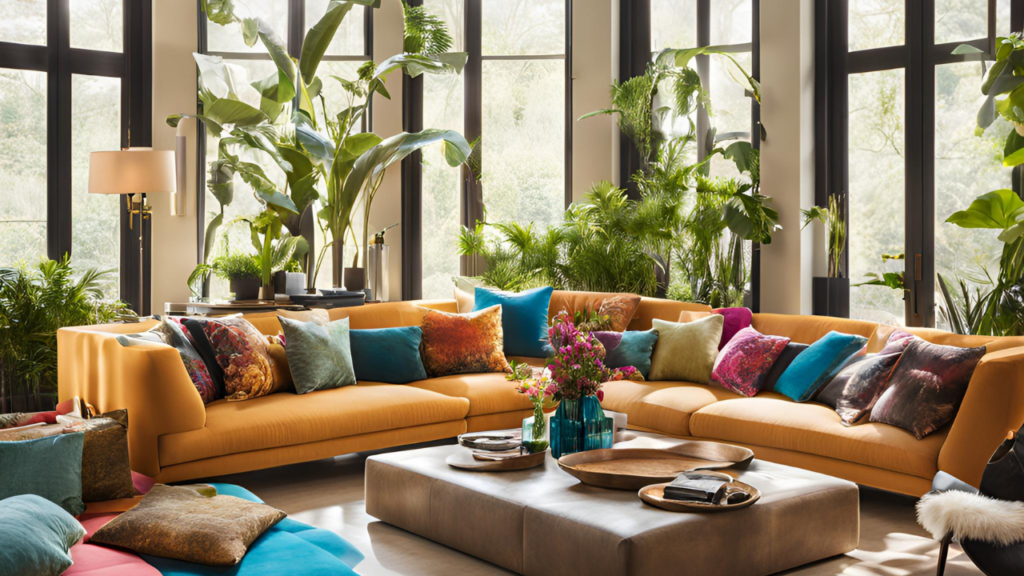
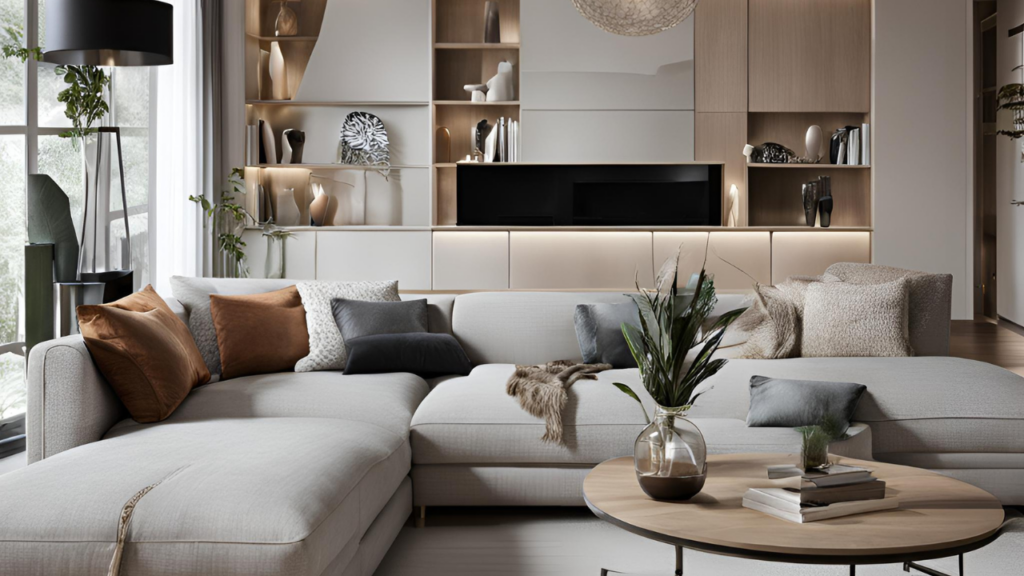
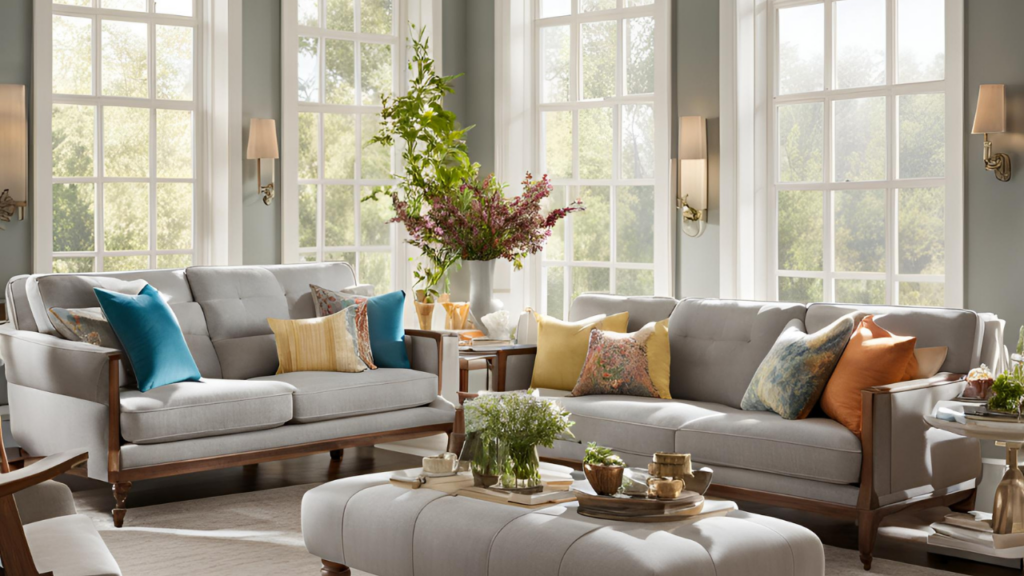
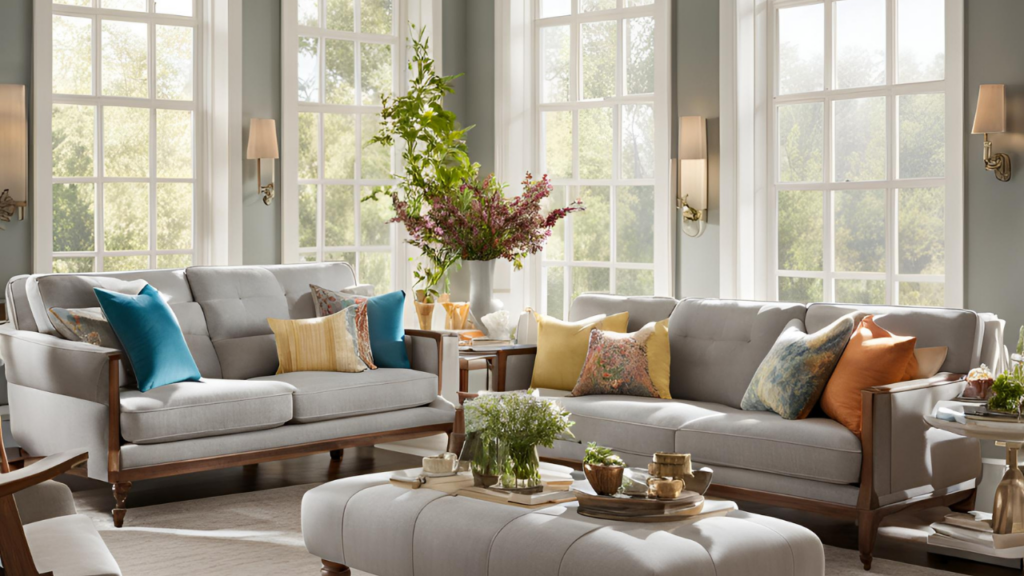
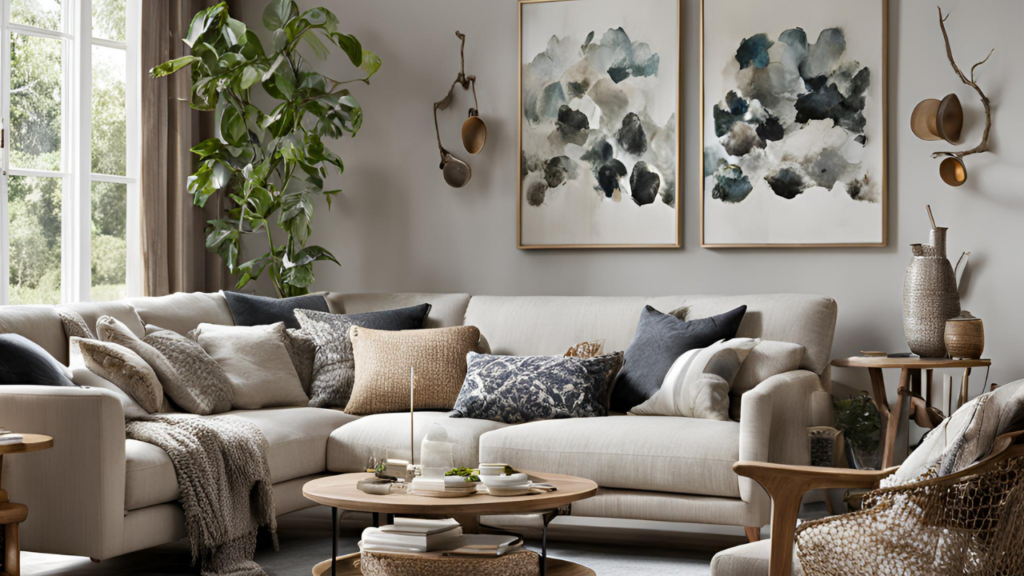
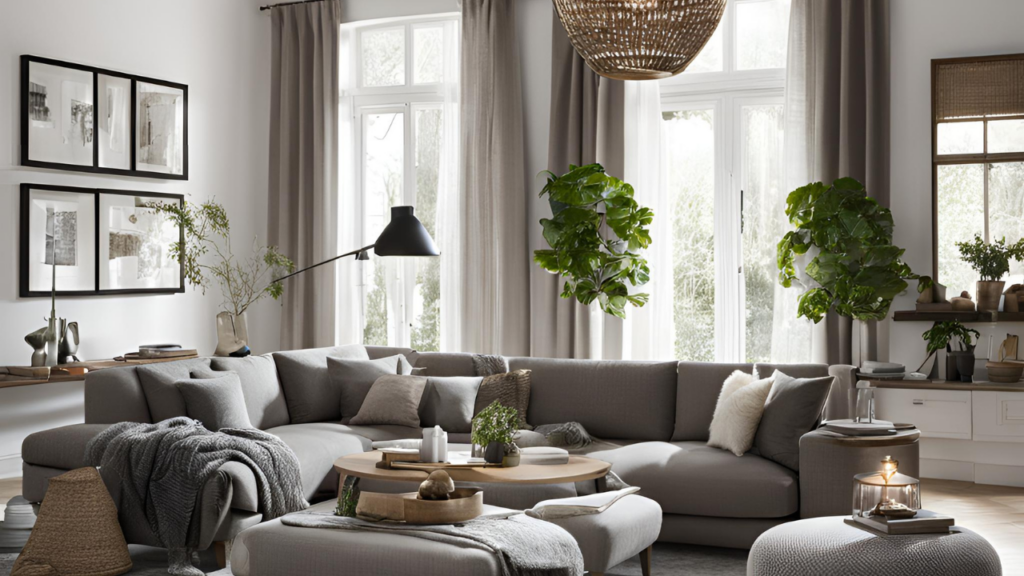
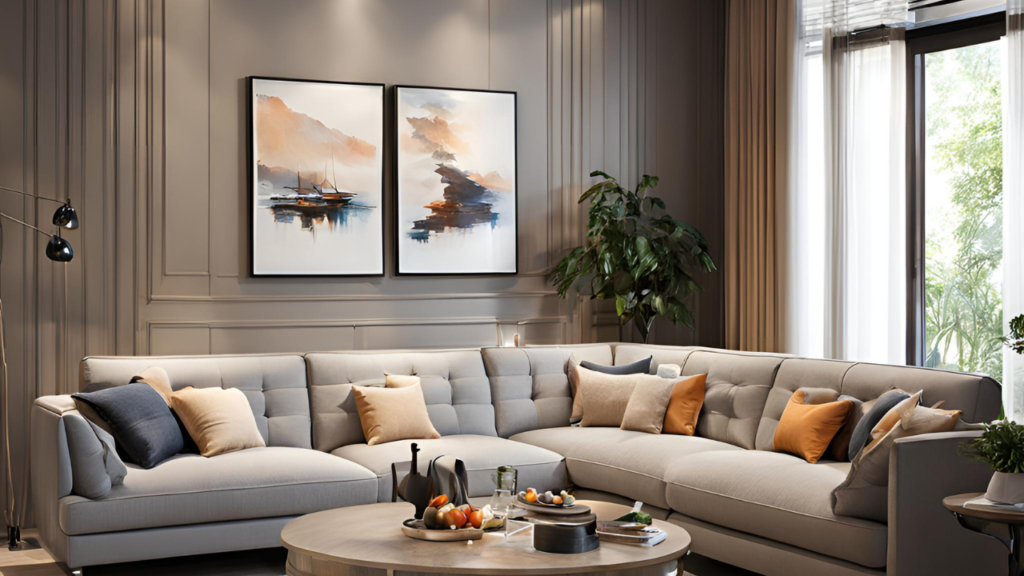
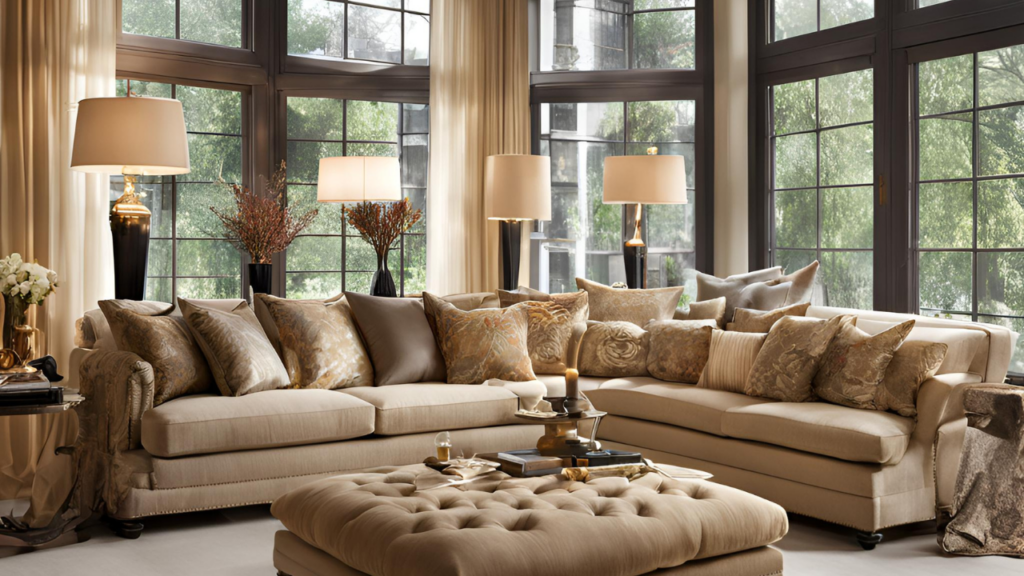
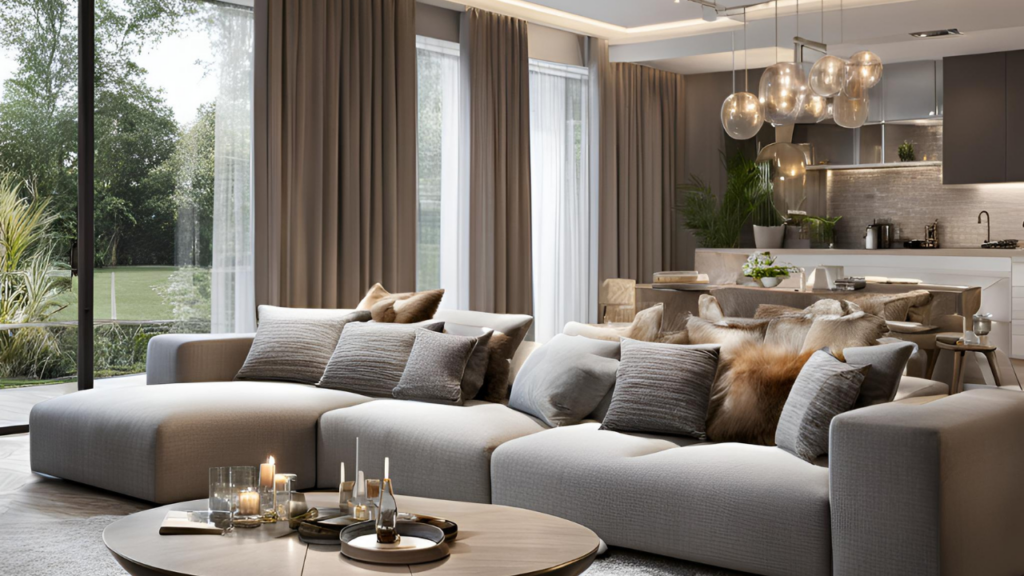
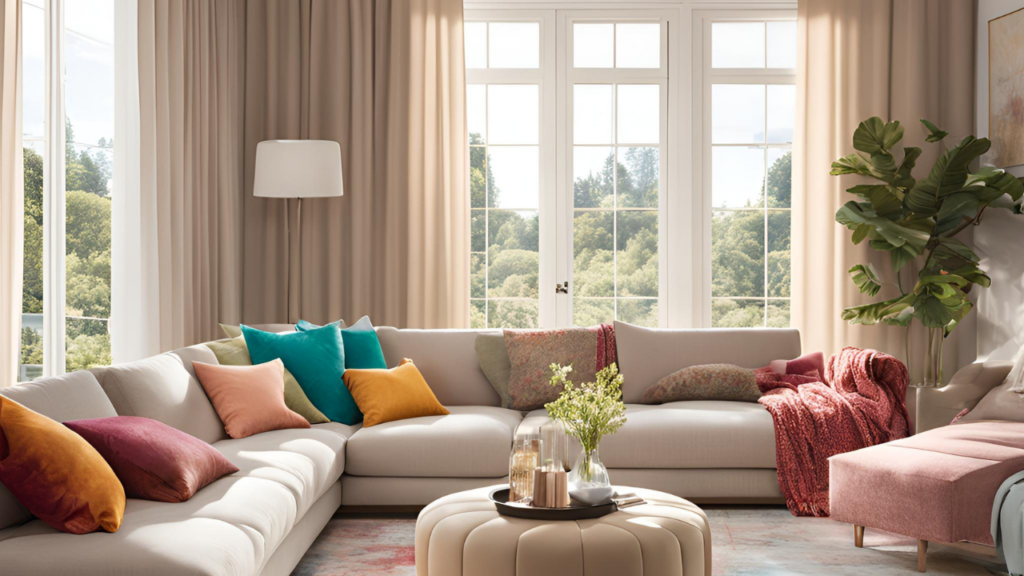
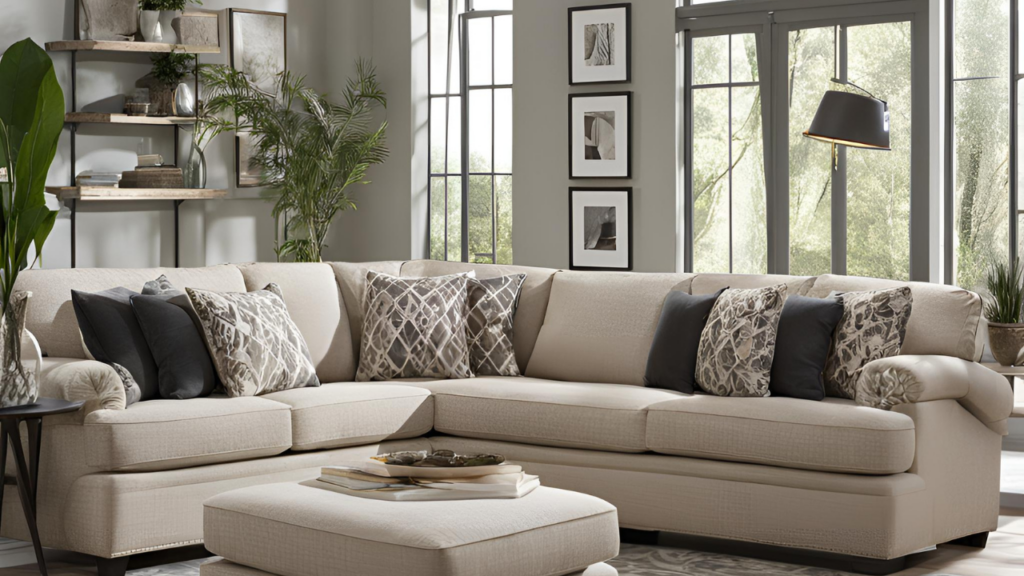
Conclusion
Creating the perfect living room sofa setup is a fun journey. It lets you make a space that shows off your style and meets your needs. Think about focal points, traffic flow, symmetry, and your home’s architecture to make a layout that looks good and works well.
Choose the right sofa, like an L-shaped, sectional, or recliner, to find the perfect balance. Mix furniture arrangement, colors, and textures to make your living room welcoming and comfy. Try out different layouts, play with lighting, and let your creativity flow to make your living room feel like home.
The beauty of arranging your living room sofa is its flexibility. Be open to changing things and trying new ideas. This way, you’ll create a living room that fits your lifestyle and style perfectly.
FAQ
What is the best way to position the sofa and other furniture in a living room?
Start with the largest piece, usually the sofa, and place it where the room’s main feature is. Add smaller seating like chairs or love seats opposite or next to the sofa. Use accent furniture like ottomans, coffee tables, end tables, and lamps to fill in. Make sure each seat is near a tabletop surface.
How should I arrange furniture in a living room with a fireplace?
A fireplace is often the main focus in a living room. Put the main sofa towards the fireplace and arrange other seating around it. This setup is great for talking and you can also have a TV on one wall if you want.
What is the best way to arrange furniture in a small living room?
Don’t push all your furniture against the walls. Instead, pull it towards the center to make the room feel bigger. Use light and flexible pieces like chairs and ottomans that can be moved easily.
How can I define different activity zones in an open-concept living room?
Use furniture to divide the space into different areas. For example, a table and chairs can be for meals or games. A sofa and chairs can be for talking by the fireplace.
How can I use an area rug to unify a seating group?
Use a big area rug to tie together a seating group. Make sure all key furniture pieces fit on the rug. If the rug is too small, at least ensure the front legs of each piece are on it.
How can I create a cozy and intimate setting in a large living room?
Divide a big living room into two areas with a path between them. Place one sofa with its back to the path to separate the areas. This makes each group more intimate.
What is the best furniture arrangement for a living room focused on conversation?
If your living room is for chatting, place the seating close to the room’s center. Arrange it so everyone can see each other. Add a coffee table in the middle for drinks, making conversation easy.
How can a sectional sofa be used in a living room?
A sectional sofa is great for lounging and watching TV. It comes in many styles, including armless chairs, love seats, and ottomans. You can mix and match to fit your space.
What should I consider when planning the traffic flow in my living room?
Think about where people will move through the room when placing furniture. Make sure there are clear paths. This makes the room welcoming and functional.
How can I achieve a sense of balance and order in my living room layout?
For balance, arrange identical sofas or chairs facing each other. If your furniture isn’t a match, use pieces of similar size to create symmetry.
How does the shape of my living room affect the furniture arrangement?
The shape of your room affects your furniture setup. For a long room, an L-shaped setup with a sofa and loveseat works well. In a square room, a symmetrical layout with matching furniture is better.
How can I make the most of a small living room?
Choose smaller furniture for a small living room. Using chairs instead of sofas makes the room feel bigger. Small stools are good for extra seating without taking up too much space.
What is a good furniture arrangement for a small living room?
Use an L-shaped setup with a sofa and love seat and a large coffee table. Add an end table or lamp in the corner. This layout is cozy and makes the most of the space.
How can I add dimension and create a welcoming pathway in my living room?
Arrange furniture diagonally to add depth and create a pathway. Use the sofa and coffee table as the main axis. Add more seating along this axis for a welcoming feel.
How should I consider the architecture of my home when arranging living room furniture?
Think about your home’s design when arranging furniture. Features like big windows or a fireplace are natural focuses. Place seating like sofas or chairs around these to create a beautiful and practical layout.

